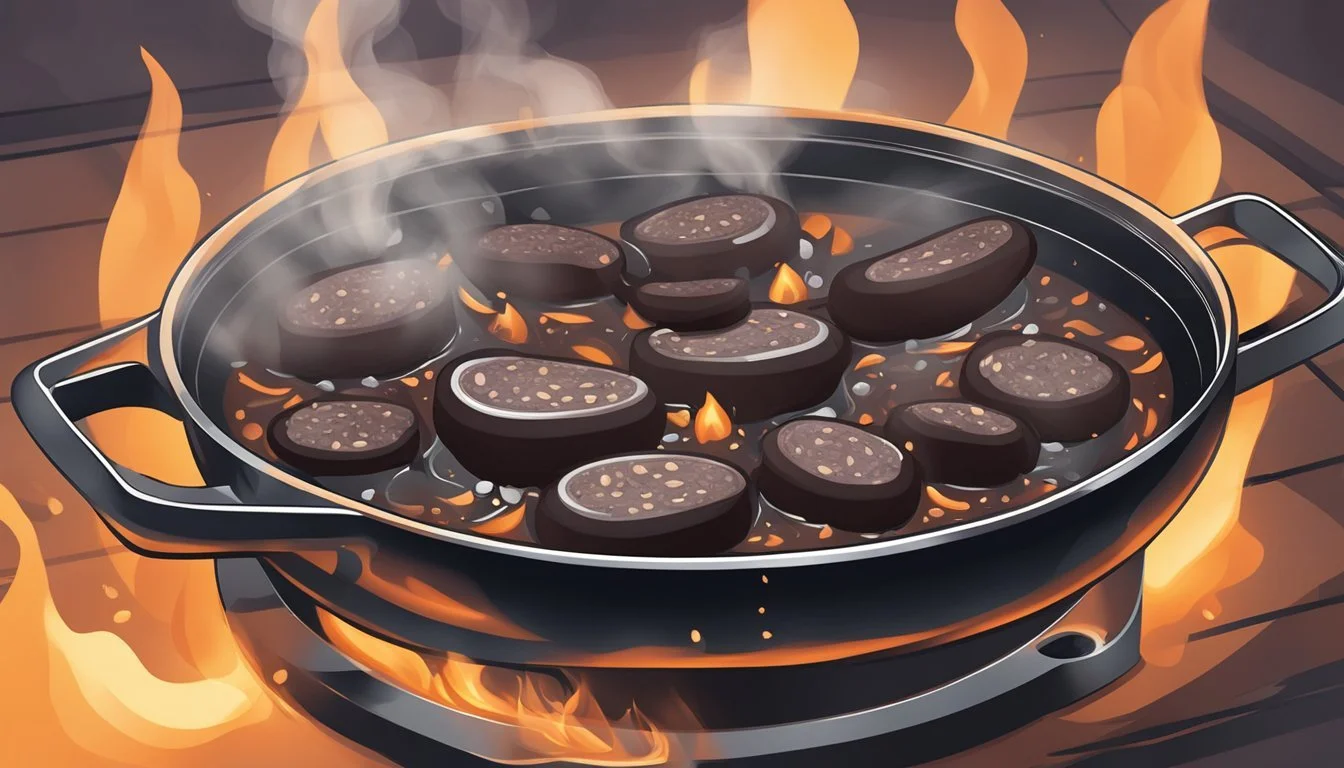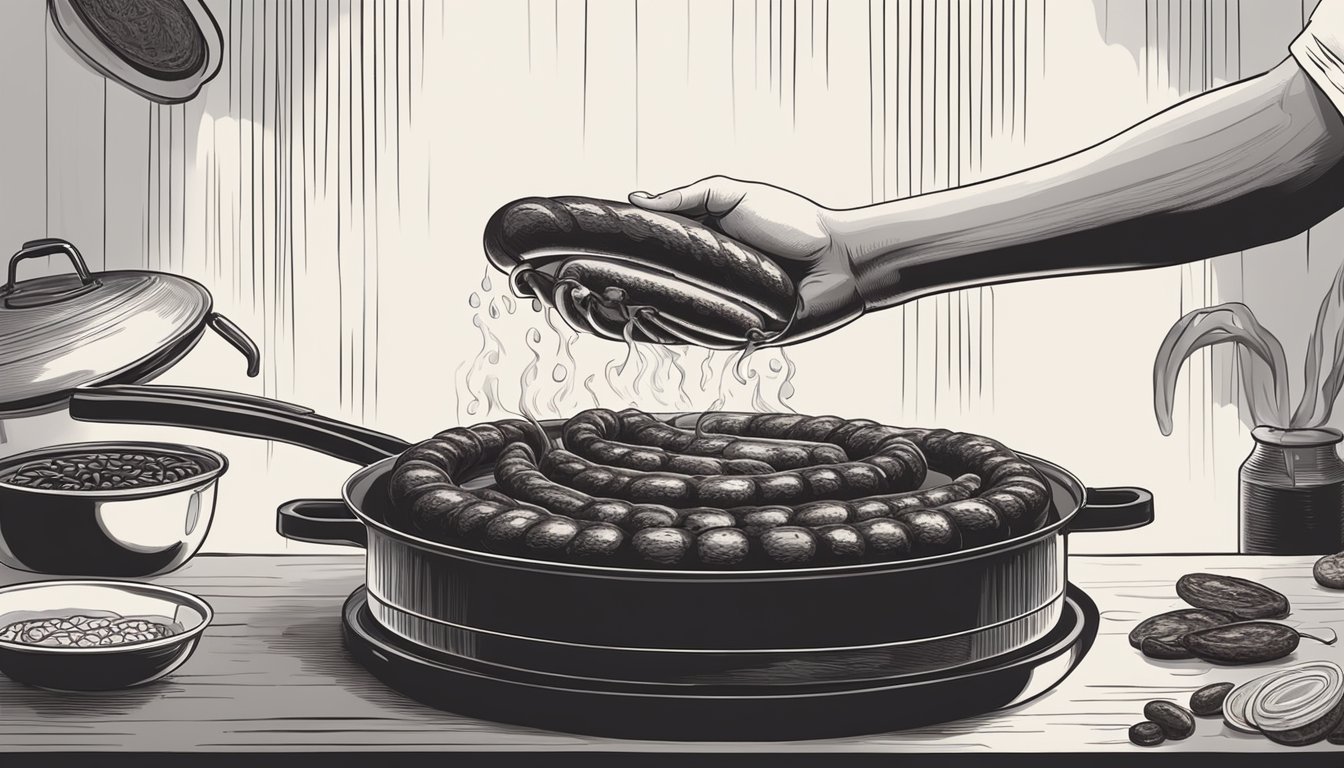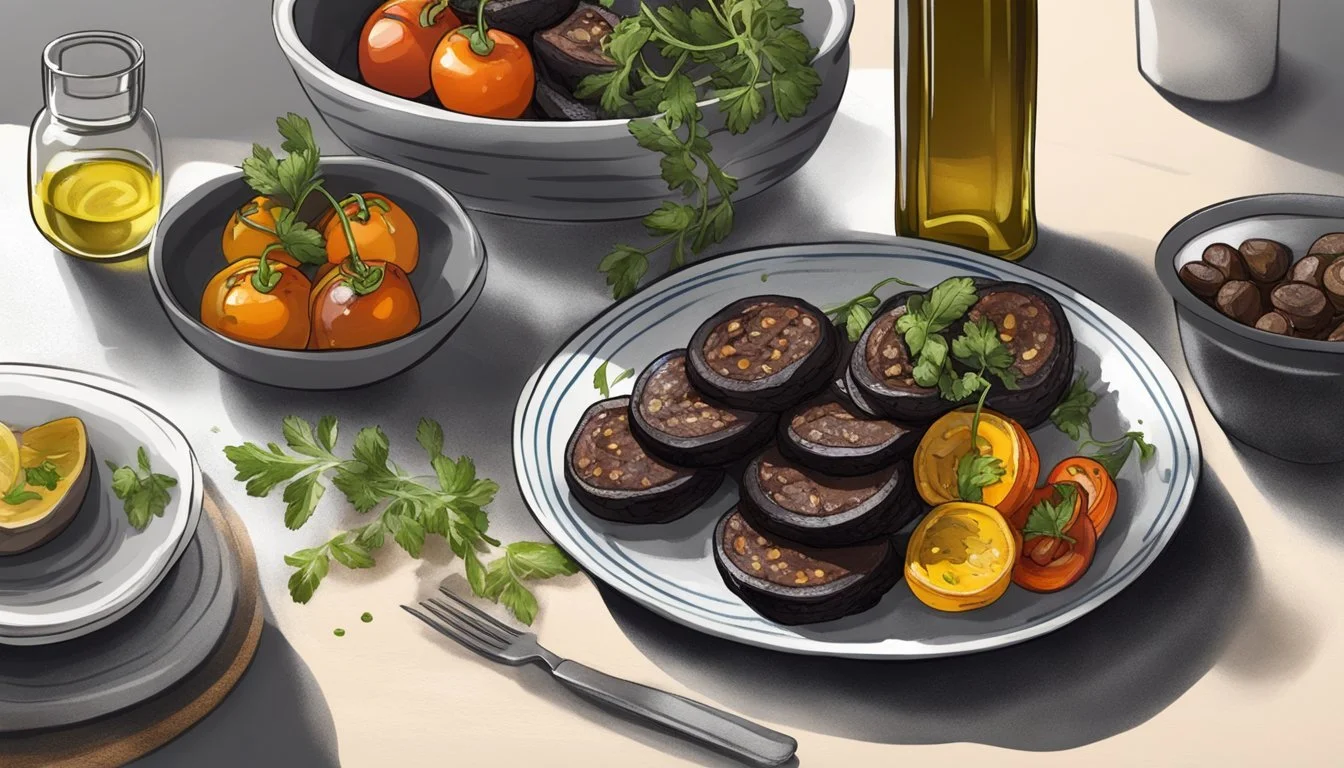How to Reheat Blood Sausage (Morcilla)
Best Methods and Tips
Reheating blood sausage, or morcilla, is an art that involves preserving its distinct flavors while ensuring it remains succulent and delicious. Blood sausage, a staple in many culinary traditions, especially in Spanish cuisine, can be enjoyed fresh or reheated to perfection. To reheat blood sausage and retain its rich, savory taste, gently steaming or pan-frying is most effective.
Morcilla, known for its unique blend of rice, onion, pork fat, blood, and spices, requires careful handling to maintain its texture and taste. When reheating, it is crucial not to overcook the sausage, which can cause it to dry out or become overly tough. Lightly oiling the sausage and reheating it slowly at a medium temperature helps maintain its original flavor profile.
In Spanish culinary traditions, morcilla is often enjoyed both as a tapas dish and as an ingredient in various recipes. Whether you choose to steam it to gently warm through or pan-fry for a slightly crisp exterior, the key is patience and attention to detail. This ensures that the morcilla retains its cherished position in your meal, offering an authentic taste of its rich heritage.
Historical Context and Varieties of Morcilla
Morcilla, a traditional Spanish blood sausage, traces its origins to the early days of pig slaughtering. It was one of the first products made from a freshly butchered pig, incorporating pig's blood, onions, and various seasonings. This sausage has been a staple in Spanish cuisine for centuries, beloved for its rich flavors and versatility.
Regional Varieties:
Different regions in Spain have their own unique versions of Morcilla. Each type reflects local ingredients and culinary traditions. Some notable varieties include:
Morcilla de Burgos: Originating from the province of Burgos, this variety includes rice, onions, pork fat, and blood. It is famous for its balanced taste and is used in many traditional dishes.
Morcilla de Granada: This version features pork belly, jowl, fat, blood, onions, oregano, and paprika. It is often enjoyed as a tapas or snack.
Morcilla Dulce: Known for its sweet flavor profile, this type is made with sugar and cinnamon, providing a distinct taste compared to its savory counterparts.
Noteworthy Regions:
Extremadura: Known for its rustic and earthy Morcilla, often incorporating local spices and herbs.
Seville: Home to a popular variety that uses a mix of traditional seasonings to create a distinctive regional flavor.
Morcilla's historical context and regional varieties underscore its significance in Spanish culinary traditions. Each type offers a unique taste experience, reflecting the diverse cultural landscape of Spain.
Selecting Quality Morcilla for Reheating
To ensure optimal flavor and texture when reheating morcilla, selecting high-quality blood sausage is crucial. Focus on finding fresh, well-made products with premium ingredients and proper handling.
Where to Buy Morcilla
High-quality morcilla can be found at reputable shops, specialized charcuterie stores, and well-stocked supermarkets. Specialty shops often have a wider selection and knowledgeable staff to guide you. Look for retailers with a focus on Spanish or Latin American foods. Buying from a known deli with good reviews ensures you get fresh, well-prepared blood sausage.
Some popular options:
Upscale supermarkets: Usually have a dedicated charcuterie section.
Spanish specialty shops: Offer authentic varieties.
Online gourmet stores: Convenient but check reviews.
Identifying Freshness and Quality
Freshness is key. Check the sell-by date and ensure the casing is intact and not dried out. The sausage should be firm, not overly soft or mushy.
Signs of Fresh Morcilla:
Firm texture: Should not be excessively soft.
Bright appearance: No discoloration or dryness.
Aroma: Should have a pleasant, slightly spicy smell, not sour.
Ask vendors about their sausage's production date and storage conditions. Fresh blood sausage often looks glossy and plump.
Understanding Morcilla Ingredients
Morcilla is made from a blend of unique ingredients. Recognizing them helps select quality products. Traditional morcilla includes blood, rice or bulgur, onions, spices, and natural casings.
Key Ingredients:
Blood: Essential for authentic taste; look for sausages made with fresh blood.
Rice or bulgur: Adds texture; avoid overly crumbly sausage.
Spices: Commonly include paprika, garlic, and pepper; check for balanced seasoning.
Natural casings: Indicate artisanal quality.
A well-prepared morcilla should have a balanced ratio of fat to lean ingredients, providing a rich flavor without being greasy. Look for clear labeling and ask about any preservatives or artificial additives.
Preparation Before Reheating
Proper preparation ensures that your blood sausage retains its texture and flavor during reheating. Key steps include thawing frozen morcilla and handling it correctly during slicing.
Thawing Frozen Morcilla
If the blood sausage is frozen, it’s crucial to thaw it correctly to maintain its texture and flavor. The best method is to transfer the sausage from the freezer to the refrigerator. Place it on a plate or in a shallow dish to catch any drips. Allow it to thaw slowly overnight or for about 24 hours.
Avoid thawing the sausage in the microwave or at room temperature. Rapid temperature changes can cause the casings to burst, compromising texture. Thawing in the refrigerator keeps the sausage at a safe temperature, reducing the risk of bacterial growth. If you’re in a hurry, you can submerge the sealed package in cold water, changing the water every 30 minutes.
Handling and Slicing
Proper handling is essential to preserve the integrity of the blood sausage. Before slicing, ensure the sausage is thawed to prevent the casings from tearing. Use a sharp knife to cut the sausage into even slices, approximately 1/2 inch thick. This size ensures the sausage heats evenly and retains moisture.
Handle the sausage gently, especially if it includes delicate ingredients like pork blood, rice, or spices. Heating oil in the pan beforehand can also help prevent the sausage from sticking and ensure a consistent reheating process. Always pierce the casing lightly with a fork to prevent bursting during reheating.
Reheating Techniques
Reheating blood sausage, or morcilla, requires specific techniques to retain its rich flavor and moist texture. Below are various methods, each suited for different kitchens and preferences.
Using a Stove
Using a stove to reheat morcilla can help maintain its succulent texture.
Preparation: Slice morcilla into even pieces for uniform heating.
Frying Pan: Place a non-stick frying pan over medium heat. Add a small amount of olive oil.
Cooking: Once the oil is hot, add the morcilla slices. Cook for 2-3 minutes on each side until heated thoroughly.
Turning: Regularly flip the slices to ensure even heating and to prevent burning.
The result should be warm and crispy exterior with a soft inside.
Oven-Based Methods
Reheating morcilla in the oven ensures even temperature distribution.
Preheating: Preheat the oven to 325°F (165°C).
Preparation: Wrap each piece of morcilla in aluminum foil to retain moisture.
Bake: Place the wrapped sausage on a baking sheet. Bake for 15-20 minutes.
Checking Doneness: Carefully unwrap one piece to check if it’s heated through. If not, continue baking in short intervals.
Final Touch: For a crispier texture, remove the foil for the last 5 minutes of baking.
This method avoids drying out the sausage while ensuring thorough reheating.
Grilling Morcilla
Grilling adds a smoky flavor to reheated morcilla.
Preparation: Preheat the grill to medium heat.
Oil Grill: Lightly oil the grill grates to prevent sticking.
Cooking: Place the morcilla directly on the grill. Grill each side for about 3-4 minutes.
Turning: Rotate frequently to achieve even heating and to enhance the exterior texture.
Resting: Let the morcilla rest for a few minutes before serving to allow juices to redistribute.
Ideal for outdoor cooking, grilling enhances morcilla's natural flavors.
Utilizing a Microwave
A microwave is the quickest way to reheat morcilla, suitable for busy schedules.
Preparation: Place morcilla slices on a microwave-safe plate.
Covering: Cover with a microwave-safe lid or plastic wrap, leaving a small vent for steam.
Heating: Microwave on medium power for 1-2 minutes. High power can cause uneven heating and texture changes.
Checking: Check the temperature and texture after the first cycle. Continue heating in 30-second intervals if needed.
Even Heating: Rearrange slices between intervals to ensure all pieces are evenly heated.
While quick, care must be taken to avoid drying or overcooking.
Serving Suggestions for Reheated Morcilla
Reheated morcilla (blood sausage) is a versatile dish that pairs well with various side dishes and accompaniments. From traditional Spanish pairings to innovative contemporary ideas, there are numerous ways to enjoy this flavorful sausage.
Traditional Spanish Pairings
In Spain, morcilla often accompanies classic dishes like cocido madrileño, a hearty stew featuring chickpeas, vegetables, and potatoes. Another popular method is serving it as part of a tapas spread, combined with olives, cheese, and crusty bread.
For a comforting meal, consider pairing reheated morcilla with papas (potatoes). In particular, it can be enjoyed with fried potatoes or mashed potatoes, enhancing their creamy texture with the rich taste of the sausage.
Contemporary Serving Ideas
Modern interpretations include using reheated morcilla in breakfast dishes. Add it to scrambled eggs or an omelet for a bold start to the day.
Another idea is to create a blood sausage and potato hash, combining crispy potatoes and savory sausage pieces. This twist can be served with a fresh side salad or sautéed vegetables for a well-rounded meal.
Consider using reheated morcilla as a topping for gourmet pizzas, where it pairs well with caramelized onions, peppers, and fresh herbs.
Accompaniments and Garnishes
Morcilla can be elevated with thoughtful garnishes and side dishes. Complement it with roasted vegetables like bell peppers, zucchini, and eggplant, which balance its richness with their natural sweetness.
For a refreshing contrast, serve reheated morcilla with a side of mixed beans or a crisp green salad dressed in a light vinaigrette.
Additionally, morcilla pairs wonderfully with spiced mashed potatoes or patatas bravas—crispy potatoes topped with a spicy tomato sauce. The heat from the sauce contrasts nicely with the deep flavors of the morcilla.
By exploring both traditional and contemporary serving suggestions, reheated morcilla can become a rewarding addition to various meals, whether enjoyed alone or as part of a more elaborate dish.
Safety and Storage
Proper storage and recognizing spoilage are crucial for ensuring your blood sausage remains safe to eat. These practices also help in maximizing the shelf life of the sausage.
Proper Storage Practices
Store blood sausage in the refrigerator at or below 40°F (4°C). To maintain its freshness, wrap it tightly in plastic wrap or aluminum foil.
Use an airtight container for better protection from exposure to air and contaminants.
For longer storage, consider freezing the blood sausage. Before freezing, ensure it's well-wrapped in freezer-safe materials. Label the package with the date to keep track of its storage time. Frozen blood sausage can last up to six months without significant loss of quality.
Recognizing Spoilage
Recognize spoilage by paying attention to appearance, smell, and texture. If the sausage develops a sour or off smell, discard it immediately.
Check for any signs of mold or discoloration on the surface. Spoiled blood sausage might also feel slimy or sticky to the touch, indicating bacterial growth.
Trust your senses. If anything seems off, it’s best to err on the side of caution and dispose of the sausage to avoid foodborne illnesses.
Maximizing Shelf Life
To maximize shelf life, keep the blood sausage in the coldest part of the refrigerator. Avoid leaving it out at room temperature for extended periods, as this can promote bacterial growth.
When reheating, ensure it reaches an internal temperature of at least 165°F (74°C) to kill any harmful bacteria. This ensures both safety and flavor retention.
If you freeze blood sausage, use a high-quality freezer bag or vacuum seal for optimal preservation. This prevents freezer burn and maintains the sausage's quality over time.
By following these storage tips, you can enjoy your blood sausage safely and maintain its rich flavors for longer periods.
Nutritional Information
Blood sausage, known as morcilla in many regions, offers a rich nutritional profile.
A typical serving size of 100 grams contains the following macronutrients:
Nutrient Amount Calories 379 kcal Protein 14.5 grams Fat 35 grams Carbohydrates 8 grams Iron 35% DV
Blood sausage is notably high in protein. Protein is essential for muscle repair and growth.
Iron is another vital nutrient found in morcilla. Iron is crucial for red blood cell production and helps prevent anemia.
While rich in nutrients, morcilla also has a high fat content. Most of the fat is saturated fat, which should be consumed in moderation.
The carbohydrate content varies slightly depending on additional ingredients like rice or onions.
In moderation, blood sausage can be part of a balanced diet. Its high protein and iron can complement other nutrient-dense foods, offering variety and taste. Care should be taken to balance it with other lower-fat food options.
Overall, blood sausage is nutrient-rich but should be enjoyed mindfully due to its fat content.
Alternatives and Substitutes
For those looking for alternatives to traditional blood sausage or wishing to try plant-based options, there are several creative choices available. Additionally, recipes inspired by the flavors of morcilla can provide a unique twist.
Vegetarian and Vegan Substitutes
Vegetarian and vegan substitutes for blood sausage can be both flavorful and satisfying. Lentils are a popular choice due to their similar texture and ability to absorb spices and herbs. A mixture of lentils, oats, and finely chopped mushrooms can mimic the granular texture and umami flavor of blood sausage.
Other plant-based ingredients, such as tempeh and seitan, can also be seasoned with traditional spices like paprika, cumin, and black pepper to create a similar flavor profile. Combining these ingredients with garlic, onions, and fresh herbs can enhance the taste and provide a rich, savory experience akin to morcilla.
Morcilla-Inspired Recipes
Creating morcilla-inspired dishes can bring the essence of blood sausage to various meals. One popular approach is to incorporate the spices and herbs commonly used in morcilla into other dishes. For instance, a lentil stew with onions, garlic, paprika, and cumin can evoke the flavors of blood sausage.
Another idea is to prepare stuffed vegetables, such as bell peppers or zucchini, with a mixture of rice, spices, and finely chopped vegetarian sausage substitutes. The inclusion of traditional ingredients and seasonings ensures the resulting dish maintains a resemblance to the classic morcilla taste.
These alternatives and inspired recipes offer delicious ways to enjoy the rich flavors of blood sausage without using its traditional ingredients, accommodating various dietary preferences and needs.






